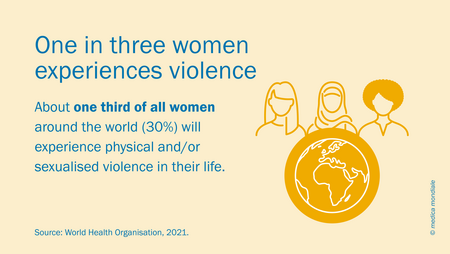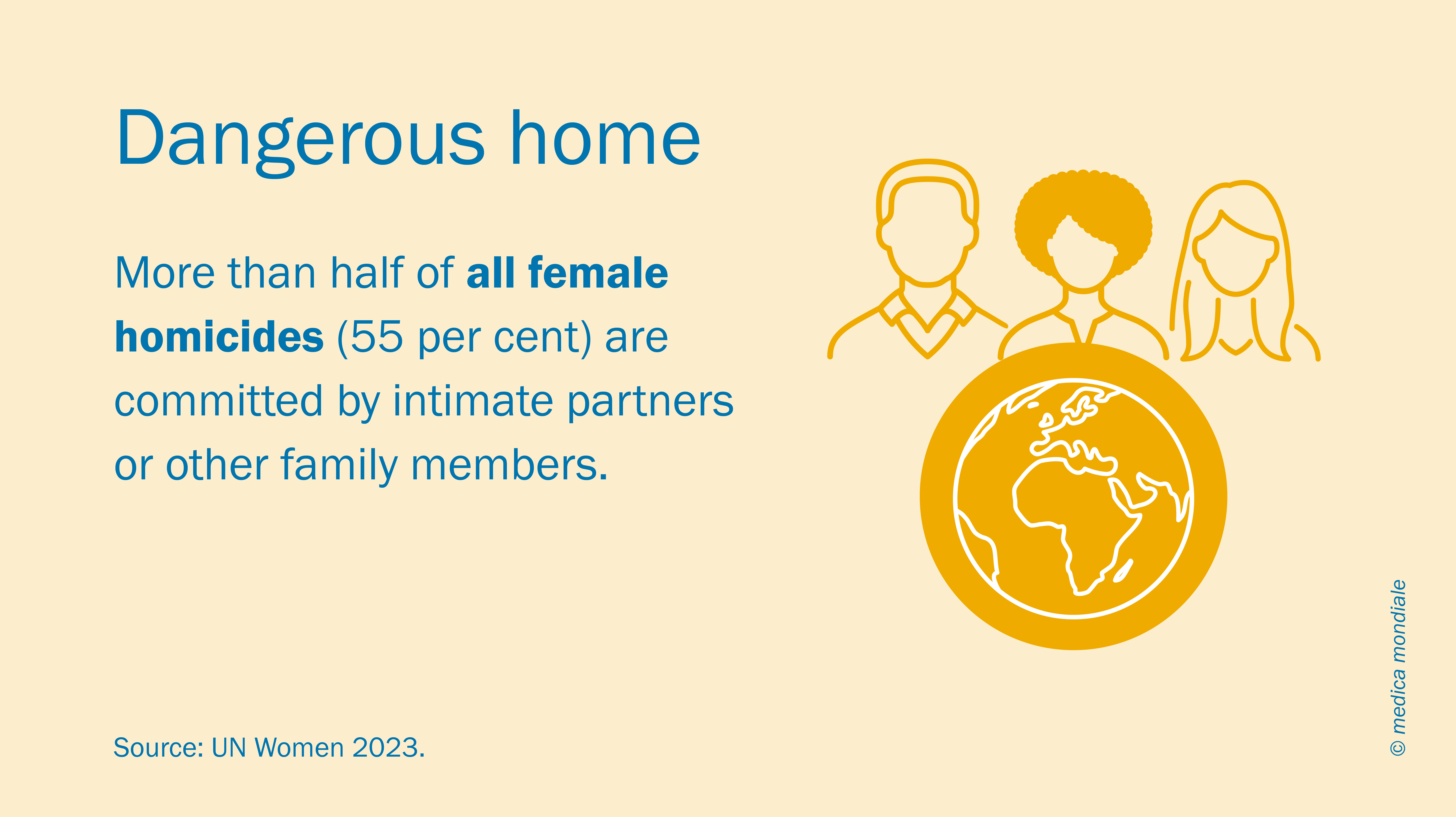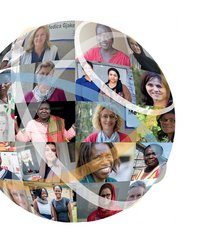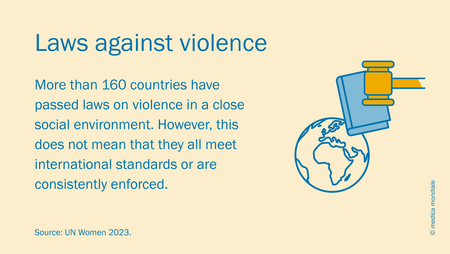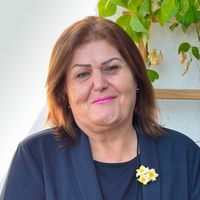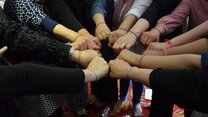Violence against women: Causes and consequences

Violence against women is one of the most frequent human rights violations. It is a threat to women’s lives, it puts their physical and psychological health at risk, and it is a threat to the well-being of their children. Violence against women has consequences for society as a whole. The perpetrators can be found in every social and economic milieu, and most of them are male.
In societies shaped by patriarchy, violence against women is an expression of unequal power relationships between men and women. So the causes of this violence are to be found not only at the individual level but also, and particularly, at the structural level. These causes need to be eliminated in order to prevent further violence. Gender justice cannot be established unless misogynist structures are resolved. Only then will women and girls be able to live a life free of violence.
What forms does this violence take?
There are various ways in which violence manifests: sexualised, physical, psychological, social, and financial violence. Sexualised violence is one form of gender-based violence and is an expression of discrimination. Women are not only discriminated against on the basis of their gender. They are also often subjected to additional forms of discrimination, such as racism, homophobia or ableism, which influence and reinforce each other.
What is ‘domestic violence’?
‘Domestic’ or ‘family’ violence, also known as ‘intimate partner violence’, refers to any violence committed by people within close social relationships. This is an internationally recognised violation of human rights. The purpose of this violence is to exercise control and power. Although the term ‘domestic’ might be thought of as referring to a house or household, the violence is often committed within the wider family or by a former partner. It is not the place of the incident that defines this form of violence, but the person perpetrating the violence, so medica mondiale prefers to use terms such as ‘intimate partner violence’ or ‘violence in a close social environment’ instead of ‘domestic violence’.
What is psychological violence?
Psychological violence refers to actions which lead to emotional and mental injuries of those affected. Psychological violence manifests itself as intimidation through looks, gestures or shouting, in coercion and in threats - such as the threat of taking children away from a woman or threatening to use physical violence. Humiliation, derogatory and discriminatory comments, and public ridicule are also forms of psychological violence. Emotional violence is often accompanied by controlling or dominating behaviour, extreme jealousy, or the isolation of those affected. Psychological violence can also occur online in the form of ‘cyber violence’.
What does the term ‘sexualised violence’ mean?
Sexualised violence refers to sexual acts against the will of the other person. This is a crime against the legally protected right to sexual self-determination. Sexualised violence is one form of gender-based violence. It ranges from verbal harassment through unwanted touching all the way to rape and female genital cutting.
Why is sexualised violence carried out?
Sexualised violence is always a way to exercise power, control someone, or oppress the other person. This takes the form of violent sexual actions which are not consensual. In other words, the emphasis is on ‘violence’, and this is sexualised: the aim is not primarily sexual satisfaction.
Under what conditions is sexualised violence carried out?
Sexualised violence is a serious violation of human rights. In situations of crisis and war it is commonly used as an instrument of power and its use continues in times of peace, too. It is an expression of patriarchal structures and is widespread around the world in all cultures, religions and societies. Sexualised violence can be found in all social and economic milieux.
What are the consequences of sexualised wartime violence?
In wars, one of the reasons sexualised violence is used against women is to humiliate the men on the opposing side. It is a gruesome, symbolic message with roots in patriarchal ways of thinking. In fact, part of the reason why sexualised wartime violence can be used with these impacts is because all sides in the conflict share this way of thinking. Worldwide, women and especially their bodies are still treated as the property of their husbands, fathers and families.
What is the symbolic message of sexualised wartime violence?
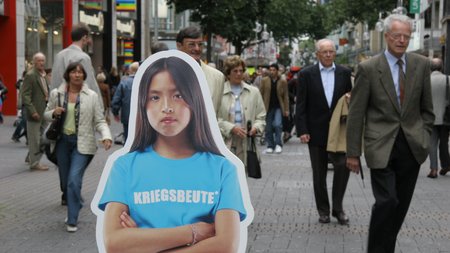
If a woman is raped, this is often considered to be damage to the property of the man (i.e. her body). The message to the enemy is that he was not able to protect his woman. Wartime rapes often also involve a combination of sexist and racist motivation: a woman is seen as a symbol of another ethnic group, and raping her demonstrates the supposed superiority of the perpetrator’s own group over that other group.
Who are the perpetrators of violence against women?
Among the perpetrators of violence against women there are people from every society, nationality, religion, age, educational level or economic background. The majority of perpetrators across the world are male, and in the case of sexualised violence they are almost exclusively male. Most come from the close social environment of those affected. The widespread image of rape being committed at night in the park by an unknown person is actually much rarer. The perpetrators bear sole individual responsibility for their actions and need to be brought to justice. It is, however, also relevant to recognise the structural causes of violence and to combat these.
What are the causes of violence against women?
The person affected by the rape is never the person responsible for that violence. Neither her behaviour, her appearance nor her clothing can justify the violence. Examples of causes at the structural level include the violence that is inherent in the discrimination carried out by private and public institutions or as part of political measures. The unequal treatment of women is based on outdated stereotypes and role ascriptions for men and women. The gender of a person is constructed socially. There is no exclusively ‘natural’ or ‘biological’ determination of gender. This means that masculinity is also a social construct. And given the framework of patriarchal role expectations, it is often connected with aggression. In order to confront violence against women at all levels of society and to enact preventive measures, medica mondiale developed its multi-level approach.
Definition: Structural causes of violence against women
Gender-specific violence against women does not take place simply at the level of the individual, but is anchored in the cultural and institutional structures of societies. The interplay between discriminating behaviours at all three levels is then referred to as ‘structural’ violence. Structural violence can be seen, for example, in discriminatory rules, laws, traditions and customs, as well as misogynistic language. The influences of these structures have a subconscious and conscious influence on people in the way they think and in the way they behave. In turn, the people who are socialised within these structures go on to preserve them, leading to a cycle which ensures that sexism continues to exist and be manifested, in turn maintaining the violence against women that results from this sexism.
Examples of the structural causes of violence against women
Whereas dominance, power and strength are seen to be masculine, qualities such as submissive, passive or indulgent are assigned to women. Even today these attributions lead to women being excluded from important political decision-making processes and offices. This lack of representation in relevant areas of society then leads to the needs of women being neglected and violence becoming established. Reflections of this can also be seen at the level of legislation: For example, only one quarter of all countries have laws relating to rape within marriage. Even in Germany, it was only in 1997 that rape within marriage became illegal. Another example of structural violence is sexism at the workplace. This includes misogynist speech, significantly lower wages and salaries for the same work, and a much smaller proportion of women in positions of management.
Facts & figures on violence against women
- In 2022, 11,896 cases of particularly serious rape, sexual coercion and sexual assault were reported, including fatalities. 87 per cent of the victims were women. Many male offenders can expect leniency in court.
- Intimate partner violence (IPV):
- Every third day a woman is killed by her partner or a former partner.
- According to the Federal Criminal Police Office, 157,818 people were affected by intimate partner violence in 2022. Most of them were women – 80 per cent.
- More than 4,500 people have experienced sexualised violence in their close social environment. 96 per cent of them were female. The number of people affected has risen significantly over the past five years: in 2022, it was over 240,000 people – 13 per cent more than in 2018.
- Multiple discrimination: Women with disabilities and impairments are 2 to 3 times more likely to be affected by sexualised violence.
- In Europe, the number of femicides has risen significantly since 2019. The increase was highest in Greece, Slovenia, Germany and Italy.
- Prosecution of perpetrators: In a study in 2019, twice as many women as men reported being afraid of revenge or reprisal from the perpetrator of violence if they report the incident to the authorities. A case study (2019) shows how women who turned to the police in the wake of partnership violence were left without any protection from renewed violence in two out of three cases.
- Cyber violence: One in ten women in the European Union has already experienced online violence.
- Intimate partner violence (IPV): Statistically speaking, every hour more than five women and girls are murdered by a family member. Over 640 million women aged 15 and over – that’s one in four – have experienced violence at the hands of their partner.
- Prosecution of perpetrators: Of all women globally who experience violence, less than 40 per cent seek assistance. Many survivors are afraid of further violence, social exclusion and stigmatisation and/or fear that they will be denied help. Those who do look for support usually turn to friends and family members. Less than 10 per cent file a complaint with the police.
- The consequences of the climate crisis increase the risk that women and girls will experience violence.
- Multiple discrimination: For women with a disability, the risk of experiencing violence within a relationship is ten times higher than for women without a disability.
What consequences does the violence have for the women affected?

Violence can result in severe physical, psychological or social consequences, or even death. This is also true for sexualised violence. Consequences of sexualised violence can include infertility and sexually transmitted diseases, trauma, depression, anxiety and panic attacks. One of the reasons for psychosomatic complaints is the suppression of the experience of violence – something many women see themselves as being forced to do. Women are then frequently blamed for provoking the violence, or they are not believed, or they are stigmatised in their social environment.
What consequences does the violence have for the families of those affected?
Violence against women is always also violence against their children, even if these are not directly attacked. Just witnessing the violence, for example, can be enough to lead to sleep disturbances, developmental disorders, aggressiveness or anxiety. Furthermore, another very serious aspect that needs considering is the passing down of both violent behaviour and trauma to subsequent generations. Children who experience or witness violence and its consequences learn to accept this violence as a way to solve conflicts. Women who have experienced sexualised violence can pass on the traumatic experience to their children and grandchildren subconsciously as transgenerational trauma, which manifests as anxiety, stress or protective responses. This can have an adverse effect on bonding within families.
What consequences does violence against women have for society as a whole?
Violence against women has far-reaching consequences for society. Transgenerational trauma, which can be handed down from survivors of sexualised violence to their children, negatively affects the psychological health of whole families. Particularly in the case of violence experienced collectively, such as sexualised wartime violence, the adverse effects can be felt by the whole social network for generations. Patriarchal structures, based on sexism and other forms of discrimination, directly create a climate of violence in which women do not feel safe to move around in public spaces or to fully live their lives.
Due to the restrictions on women regarding their access to education or choice of profession, societies are unable to benefit from the potential of half of their population. These poor educational opportunities for girls and women then correlate directly with poverty, child and maternal mortality, as well as the climate crisis. Natural disasters can obstruct access to education. Floods destroy routes to school and classrooms, and droughts plunge families into poverty. However, the world needs well-educated girls and boys who can develop strategies to mitigate the consequences of the climate crisis and play an active role in shaping their society.
What consequences does violence against women have for the state and the economy?
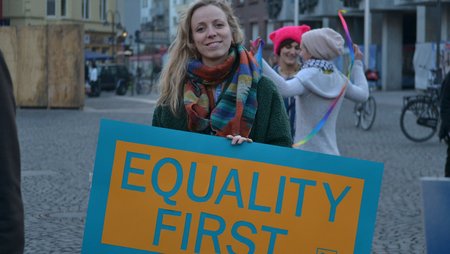
The participation of women in many political and economic sectors is severely restricted because of the discrimination against them. Studies show that the extent of participation of women has a direct influence on the stability of a state and on its economic success. Women who have been subjected to violence suffer more frequently from physical and psychological injuries, leading to their absence from the workplace, which reduces the productivity of companies and harms the national economy.
Society also bears the costs of violence against women in the form of the costs for women’s safe houses, court cases, police operations, and psychological or medical treatments. Furthermore: As is recognised in UN Resolution 1325, sexualised violence is both a serious obstacle to successful peace negotiations and also a threat to peace and stability in the long term. Peace agreements made without the participation of women or consideration of their needs cannot be successful in the long term.
Violence against women: An issue for the state
Violence against women should not be treated as a personal issue, but rather as a societal problem that can and must be prevented. However, cases of gender-specific violence, such as femicide, often appear in the media or even court cases under the trivialising term “family drama”. This choice of language is part of the structural problem making violence against women appear less harmful. It also does not clearly name the causes or those responsible. The state has an obligation to prevent violence against women. It is also obliged to provide protection and support for those affected and to pursue those who perpetrate these crimes. Unless there is an overall coherent government strategy that considers the causes of violence against women, there will be no development of measures that actually have an impact.
Examples of opportunities for the state to intervene
Training courses can be offered to staff in the healthcare and legal sectors to raise their awareness of violence against women. In particular, public information work, gender-equitable childcare and education, human rights education, and a zero-tolerance policy on violence are all measures which can prevent violence and help to counteract misogynist attitudes.
What can society do to combat violence against women?
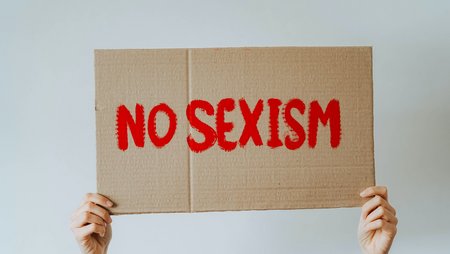
Every individual can be a role model for gender-equitable behaviour. Questioning and reflecting on our own behaviour and society’s norms can reveal where we have subconsciously adopted a sexist way of thinking and behaving that was modelled to us by or within our society.
- Solidarity with women strengthens social cohesion. It also reduces the space available to violence against women. Clearly stating that we are against every form of violence against women and discrimination helps to send the right signals.
- Another way to make a stand is to boycott misogynist products and criticise any entertainment formats that exhibit discrimination. This helps to interrupt the perpetuation of misogynist values.
- People working in sectors such as education, media, culture and advertising, or even the development of computer games, have a particular function as role models and can help to broaden the impacts of more gender-equitable portrayals.
- People who carry out violence do have individual responsibility for their actions, since they themselves can decide against violence.
- Witnesses of violence can contact appropriate counselling centres and help ensure support is arranged.
Observing and taking action: Examples of our work
medica mondiale and our partner organisations raise public awareness of sexualised violence and educate people on the causes and consequences of violence against women. The general public and decision-makers such as politicians are called upon to deal with the issue of violence against women. Our aims include measures against sexualised and gender-based violence as well as discrimination-free assistance for survivors.
1. Public awareness work: Breaking the taboo on sexualised violence
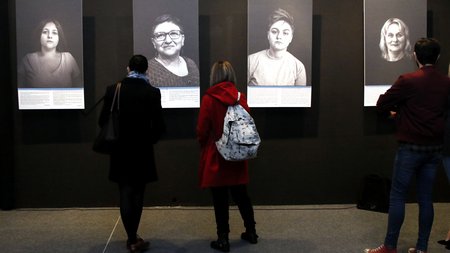
As part of our public awareness work, we contact a wide range of stakeholders in order to break down the taboo in society on this issue, and to bring about structural transformation. For example, our Bosnian partner organisation Forgotten Children of War organised a photo exhibition “Break Free” to draw attention to the situations faced by children born as a consequence of sexualised wartime violence, and their mothers. Our partner organisation medica Liberia presents radio programmes to educate village residents about women’s rights. Listeners can call in or send their questions to the legal counsellor as a text message. Men are also directly addressed, in order to persuade them to actively support women and girls.
2. Integrated support for women and girls affected by violence
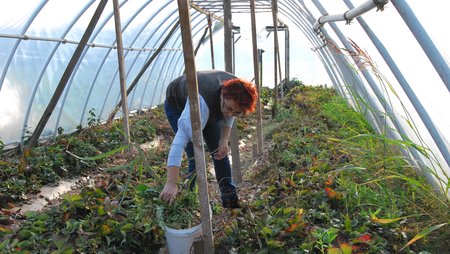
Our partner organisations provide integrated and long-term assistance to survivors of sexualised violence, adopting our Stress- and Trauma-sensitive Approach (STA)®. Examples of the support include medical and psychosocial counselling, legal assistance, and income-generating measures. Our Bosnian partner organisation Budućnost organises horticultural and agricultural training for women and girls so they can secure their own living independently.
3. Advocacy work: Structural change for women, against violence
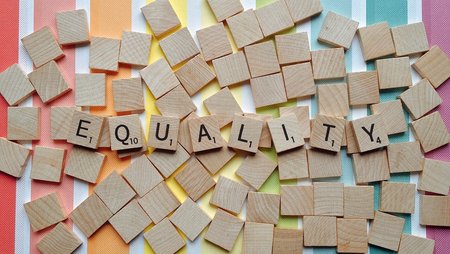
By carrying out political advocacy work, medica mondiale works together with its partner organisations to call on political actors to implement policies that meet the needs of survivors of sexualised violence. We raise awareness among politicians and governments across the world on the issue of violence against women, demanding that they uphold women’s rights and enforce existing laws to protect women. The interests and needs of survivors need to be considered in political decision-making processes. Structures that perpetuate violence need to be broken down so that violence is prevented in the long term. Additionally, we campaign actively to ensure that survivors of sexualised (wartime) violence receive appropriate support and/or compensation.
Examples from Germany, South-east Europe and Afghanistan
In Germany, medica mondiale advocates for accordance with both the Istanbul Convention against Violence on Women and the UN Agenda “Women, Peace, Security“. We are also demanding that the German government properly implements UN Resolution 1325 in order to ensure that women and girls in conflict areas are protected and have a chance to take part in peace processes. In Kosovo, Medica Gjakova contributed to the efforts that led to the awarding of a monthly pension to women and girls who were raped during the Kosovo war. And in July 2022 in Bosnia and Herzegovina, the country’s parliament passed a law on the legal recognition of people born as a result of wartime rape, after many years of campaigning by our partner organisations.
